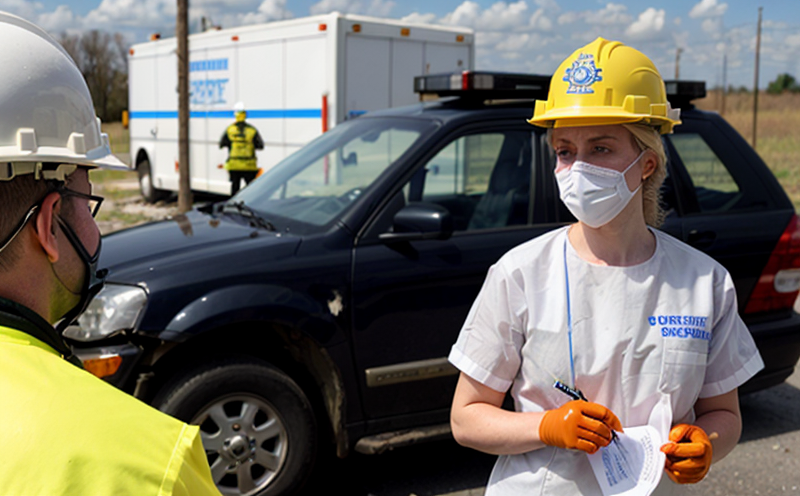ASTM E666 Thermoluminescent Dosimeter Testing After Accidents
The ASTM E666 standard provides a comprehensive approach to testing thermoluminescent dosimeters (TLDs) used in radiation and nuclear monitoring. This service is particularly critical for assessing the cumulative dose received by individuals involved in accidents or incidents involving radioactive materials.
In emergency response scenarios, TLDs are deployed on personnel, equipment, and structures to monitor exposure levels accurately. Following an accident, these dosimeters are retrieved and tested to determine the absorbed radiation dose. This testing ensures that all exposed individuals receive appropriate medical attention and allows for accurate reporting of incidents.
The ASTM E666 standard specifies precise procedures for the post-accident evaluation of TLDs. It outlines how specimens should be handled, stored, and transported to prevent contamination or degradation before testing. The standard also defines the parameters used in the testing process, including temperature and humidity conditions that must be maintained during measurement.
The testing protocol involves exposing the TLDs to a known dose of radiation and comparing it with the readings obtained from the accident site. This comparison helps validate the accuracy of the dosimeter and provides reliable data for incident investigation and response planning.
Accurate testing is crucial for several reasons:
- To ensure compliance with regulatory standards
- To provide accurate dose information to affected individuals
- To support the implementation of appropriate safety measures
- To facilitate insurance claims and legal proceedings
The ASTM E666 standard also emphasizes the importance of quality control in TLD testing. Laboratories must adhere to strict protocols, use calibrated equipment, and maintain accurate records to ensure consistent results.
In addition to the technical aspects, this service involves real-world applications that highlight its significance:
| Scenario | Description |
|---|---|
| Nuclear Power Plant Incident | In the event of a nuclear power plant accident, TLDs are used to monitor radiation levels in the vicinity. After the incident, these dosimeters are retrieved and tested to assess the cumulative dose received by personnel. |
| Radiopharmaceutical Manufacturing Plant Accident | In a radiopharmaceutical manufacturing plant accident, TLDs are deployed to monitor radiation exposure among workers. Post-accident testing ensures that all exposed individuals receive appropriate medical attention and that the facility complies with regulatory requirements. |
| Nuclear Research Facility Incident | During a nuclear research facility accident, TLDs are used to monitor radiation exposure among researchers. Post-accident testing provides accurate dose information for incident investigation and response planning. |
Applied Standards
The ASTM E666 standard is widely recognized and applied in the field of radiation and nuclear testing. It provides a robust framework for the post-accident evaluation of TLDs, ensuring accurate dose assessment.
The ASTM E666 protocol covers several key aspects:
- Handling and storage of TLDs
- Transportation of specimens to the testing facility
- Calibration of measurement equipment
- Data recording and reporting
The standard also emphasizes the importance of quality control, ensuring that laboratories conducting ASTM E666 tests adhere to strict protocols. This adherence guarantees consistent and reliable results.
Industry Applications
| Application | Description |
|---|---|
| Nuclear Power Plant Incident Response | In the event of a nuclear power plant accident, TLDs are deployed to monitor radiation levels in the vicinity. Post-accident testing ensures accurate dose assessment and supports incident investigation. |
| Radiopharmaceutical Manufacturing Plant Accident | In a radiopharmaceutical manufacturing plant accident, TLDs are used to monitor radiation exposure among workers. Post-accident testing provides reliable data for compliance with regulatory requirements and incident investigation. |
| Nuclear Research Facility Incident Response | During a nuclear research facility accident, TLDs are deployed to monitor radiation exposure among researchers. Post-accident testing ensures accurate dose assessment and supports incident response planning. |
International Acceptance and Recognition
The ASTM E666 standard is internationally recognized for its reliability and accuracy in thermoluminescent dosimeter testing. Laboratories adhering to this standard are acknowledged for their expertise in radiation monitoring.
Many countries, including the United States, Europe, and Asia, have adopted the ASTM E666 protocol as a benchmark for TLD testing. This international recognition ensures that laboratories can provide consistent results across different regions.
The standard is widely used by regulatory bodies and organizations involved in radiation safety to ensure compliance with national and international regulations. Its acceptance enhances trust in test results, facilitating effective incident management and response.





